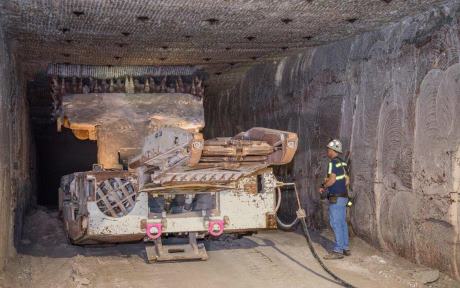Mining operations have resumed after a four-year break at the US Department of Energy's Waste Isolation Pilot Plant (WIPP). A continuous mining machine has begun cutting into panel of the underground salt formation, work that was halted following separate underground events in early 2014.
 |
| WIPP's continuous mining machine resumes operations (Image: WIPP) |
WIPP, in New Mexico, is the USA's only repository for the disposal of transuranic, or TRU, waste - clothing, tools, rags, residues, debris, soil and other items contaminated with small amounts of plutonium and other man-made radioactive elements from the US military programme. Disposal of TRU waste is critical to the cleanup of Cold War nuclear production sites.
The repository's operations were suspended in February 2014 following a fire in an underground vehicle, and, several days later, a non-related radiological event when a waste drum ruptured following an exothermic chemical reaction in organic absorbent material used in the drum to stabilise liquids and nitrate salts. Waste emplacement resumed in January 2017 following extensive investigations and the implementation of a stepwise recovery plan to mitigate the source of the contamination, restore the necessary conditions to support operations, and incorporate lessons learned from the incidents. This led to the installation of new permanent ventilation and a new exhaust shaft.
Mining at WIPP is timed so that a panel is only ready when it is needed for waste emplacement, because the natural movement of salt - the behaviour that will eventually permanently encapsulate the waste - causes mined openings to close. Mining began at Panel 8 in February 2013 but was suspended following the 2014 incidents. Completion of Panel 8 is now scheduled for 2020.
The salt is excavated using a continuous mining machine, which cuts into the salt rock with a rotating drum. More than 112,000 tonnes of salt will be removed to complete the panel, which will contain seven disposal rooms for waste emplacement. Each disposal room is 300 feet (91 metres) long, 33 feet wide and 13 feet high.
"Resuming mining operations will allow us to continue fully restoring WIPP and fulfilling our important mission of providing a transuranic waste solution for the DOE complex,” Carlsbad Field Office Manager Todd Shrader said.
Researched and written
by World Nuclear News




_18570.jpg)
_16159.jpg)
_18938.jpg)
_33584.jpg)





